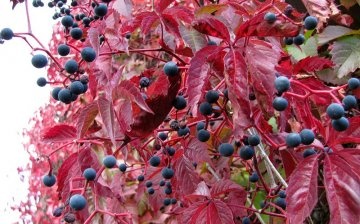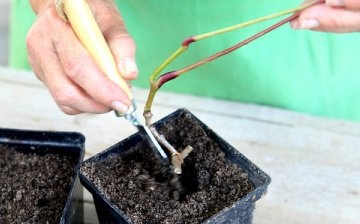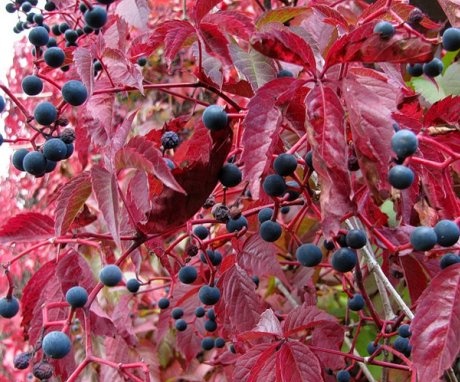Wild grapes: varieties, planting and care
Parthenocissus is the official name of the wild grapes, literally translated from Greek as maiden ivy. It is native to North America and East Asia, where it is widespread. Wild grapes refer to vines, which densely braid the supports and shed their leaves every fall.
Use it like ornamental plant for decorating arches, fences or the walls of houses. This type of plant is very popular among decorators. The reason for this is that wild grapes are unpretentious and tolerate heat and cold well. Also, its density of landscaping in summer, and a bright color in the autumn period gives any site a spectacular look.
Content:
Wild grape varieties
Most Popular varieties wild grapes:
- Ivy grapes. Liana, with densely leafy branches that stretch over 7 meters in length. Leaves are medium in size, located on a medium petiole. In the summer, they are painted in a dark green tone, by winter they are painted in burgundy and brown. The variety is frost-resistant.
- Virginian grapes. This vine stretches its branches 20 meters high, therefore it is often used for landscaping and decorating the walls of houses. Leaves are oblong-oval, lacent, with a pointed end and serrated edges, collected in five on a long petiole. They are painted in a dark green or green tone; by autumn, all the leaves are painted red.
- Wild grapes "Raspberry Wine". Perennial, branches stretch 12 m in height. Medium-sized leaves in the spring-summer period are painted green, by autumn they are painted in bright yellow, orange and red tones.
Wild grape care
One of the main points in the care of wild grapes is pruning... With an untimely shortening of the branches and the removal of excess shoots, the bush grows strongly and braids all the supports that are nearby. In order for the type of decorative grapes to be neat and well-groomed, every spring and autumn, as well as during the summer, it is regularly pruned and dry and excess branches are removed.
Water the grapes abundantly, especially if the summers are hot and dry. In winter, if conducted watering, then it is reduced by 2 times. But it is not recommended to overflow and swamp the soil, therefore, during the rains, the bush can not be watered.
In order for the bush to develop well, during the active growth of the plant, it must be fed.
Fertilizers are applied in the spring and in the middle of summer once. Bushes are planted at a distance of at least 1 meter from each other. The place is chosen well-lit, mainly from the southern side of the fence, support or house. In the shade, the grapes will not have saturated colors and the bush itself develops slowly. Also, bushes can be planted in tubs and grown on balconies. In this case, the top layer of the earth changes regularly and every spring the soil is saturated with fertilizers and top dressing.
Planting wild grapes
Wild grapes are multiplied by cuttings, layering and seeds... Spring pruning can produce good grafting material. From the branches obtained, healthy good branches are selected, the thickness of which is about 5-7 mm. Cut it so that 4-5 healthy buds remain on the handle.
Cuttings can be planted directly to a permanent place of growth, since wild grapes take root well.
To do this, you need to prepare a hole near the support. A small depression is dug, the earth is mixed with sand and compost and mixed. You can add a little more fertilizer. The stalk is immersed in a prepared hole so that two buds remain on the surface, and covered with prepared earth.
Further, the future bush is watered regularly so that the soil does not dry out completely. After 10-12 weeks, the cutting will take root.
Reproduction using layering is also easy and quick:
- A healthy, strong branch is buried at a distance of 1 meter from the mother bush. Water them together.
- Next year there will already be a separate bush and it can be separated by cutting off the connecting branch.
With the help of seeds, wild grapes are propagated in nurseries. At home, this is a painstaking and laborious process. Seeds must be kept for a certain period at a temperature of 5 degrees, then planted in black soil, previously prepared. The germination rate is low. Therefore, amateur gardeners propagate grapes with the help of cuttings and layering. At the same time, daughter plants in any generation do not lose the characteristics and characteristics of the mother bush.
Wild grapes are perennials. It develops well and is practically not exposed to diseases and attacks of insects. When the soil is waterlogged or when a plant is planted in a damp place, fungi may appear. But this happens very rarely. The bush is cut and transferred to a drier place in the spring.
More information can be found in the video.













